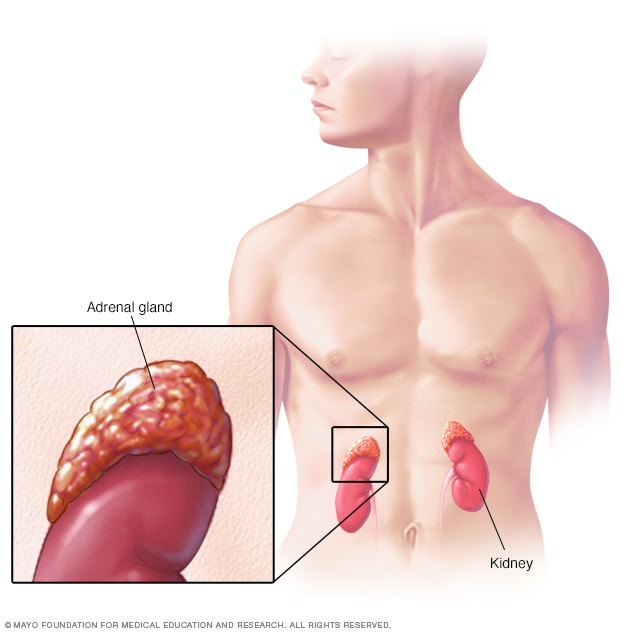Overview
Adrenal glands

Adrenal glands
Located on top of the kidneys, the adrenal glands make hormones that help regulate metabolism, the immune system, blood pressure and other important functions. Although small, these glands control much of what happens in the body.
Neuroblastoma is a cancer that starts in cells called neuroblasts. Neuroblasts are immature nerve cells. They are found in several areas of the body.
Neuroblastoma most often starts in the neuroblasts in the adrenal glands. The adrenal glands are located on top of each kidney. The glands make hormones that control important functions in the body. Other parts of the body that have neuroblasts and can get neuroblastoma include the spine, belly, chest and neck.
Neuroblastoma usually affects children age 5 or younger. Symptoms vary, depending on where it occurs in the body.
Some forms of neuroblastoma may go away on their own. Other forms of neuroblastoma need treatment. Treatments include surgery, chemotherapy, radiation therapy and bone marrow transplant. Your child's healthcare team will select the neuroblastoma treatments that are best for your child.
Products & Services
Symptoms
Signs and symptoms of neuroblastoma may vary depending on what part of the body is affected. This cancer starts in immature nerve cells called neuroblasts. Neuroblasts are found in several areas of the body.
Neuroblastoma in the belly may cause symptoms such as:
- Belly pain.
- A lump under the skin that typically isn't tender when touched.
- Diarrhea or constipation.
Neuroblastoma in the chest may cause symptoms such as:
- Wheezing.
- Difficulty breathing.
- Changes to the eyes, including drooping eyelids and pupils that are different sizes.
Other symptoms that may indicate neuroblastoma include:
- Lumps of tissue under the skin.
- Eyeballs that seem to stick out from the sockets.
- Dark circles around the eyes that look like bruises.
- Back pain.
- Fever.
- Losing weight without trying.
- Bone pain.
When to see a doctor
Contact your child's healthcare professional if your child has any symptoms that worry you. Mention any changes in your child's behavior, habits or appearance.
Causes
It's not clear what causes neuroblastoma. This cancer starts in immature nerve cells called neuroblasts. Neuroblasts are found in several areas of the body.
Neuroblastoma starts when neuroblasts develop changes in their DNA. A cell's DNA holds the instructions that tell the cell what to do. In healthy cells, the DNA gives instructions to grow and multiply at a set rate. The instructions tell the cells to die at a set time. In cancer cells, the DNA changes give different instructions. The changes tell the cancer cells to grow and multiply quickly. Cancer cells can keep living when healthy cells would die. This causes too many cells.
The cancer cells might form a mass called a tumor. The tumor can grow to invade and destroy healthy body tissue. In time, cancer cells can break away and spread to other parts of the body. When cancer spreads, it's called metastatic cancer.
Risk factors
The risk of neuroblastoma is higher in children. This cancer happens mostly in children age 5 and younger.
Children with a family history of neuroblastoma may be more likely to develop the disease. Yet, healthcare professionals think only a small number of neuroblastomas are inherited.
There are no known ways to prevent neuroblastoma.
Complications
Complications of neuroblastoma may include:
- Spread of the cancer. With time, the cancer cells may spread to other parts of the body. Neuroblastoma cells most often spread to the lymph nodes, bone marrow, liver, skin and bones. When cancer spreads, it's called metastatic cancer.
- Pressure on the spinal cord. A neuroblastoma may grow and press on the spinal cord, causing spinal cord compression. Spinal cord compression may cause pain and paralysis.
- Symptoms caused by cancer secretions. Neuroblastoma cells may secrete chemicals that irritate other tissues. The irritated tissues can cause symptoms called paraneoplastic syndromes. Symptoms of paraneoplastic syndromes may include rapid eye movements and difficulty with coordination. Other symptoms include abdominal swelling and diarrhea.
Feb. 25, 2025